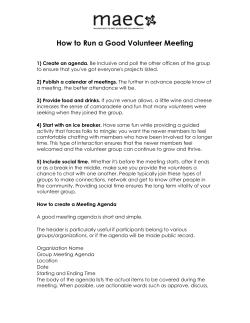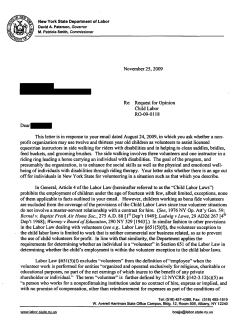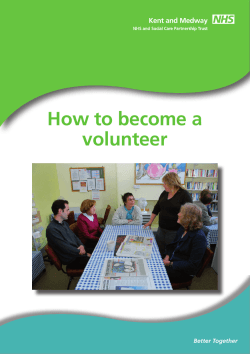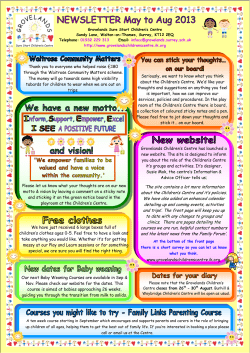
MAKING IT COUNT: HOW TO MEASURE THE IMPACT OF January 2011
MAKING IT COUNT: HOW TO MEASURE THE IMPACT OF VOLUNTEERISM January 2011 Making It Count: How to Measure the Impact of Volunteerism Introduction: What’s The Value of Time Not at Work? With arguably the most developed social sector and philanthropic market in the world, it’s safe to say that the people of the United States love to give. And while some can give money, many can and do give time. The Bureau of Labor Statistics recently reported that more than 63 million Americans volunteered in 2009, representing an increase of 1 million new volunteers than in 2008 and 8 billion total hours of service.1 This trend extends to our public leadership: President Barack Obama recognized the value of grassroots service by establishing the Office of Social Innovation and Civic Participation in an effort to support the widespread interest of service into sustainable impact. What’s more, companies of all shapes and sizes see employee volunteer programs as valuable and worthwhile, particularly in times when cash donations may simply be infeasible. Notably, in 2010, only about 10% of companies increased philanthropic giving and, in fact, 16% planned to reduce giving.2 However, over 50% of companies encouraged employees to volunteer more in the same period. Volunteers are critical to the success of nonprofit organizations, yet these organizations continue to face challenges in fully capturing the value of this workforce. A recent article by Stanford Social Innovation Review states continued volunteer engagement is a major issue – there were 61 million volunteers in 2006 but one-third of them did not volunteer time to an organization the following year.3 This highlights the critical need for improved volunteer management practices to help alleviate challenges with issues, such as matching skills with appropriate assignments, recognizing volunteers for their contributions, sufficiently training volunteer staff, including them as a leadership priority, and measuring the impact of volunteerism.3 For those involved in volunteerism – individual volunteers, sponsoring companies and benefitting organizations – such programs bring much needed skills and resources to pressing social issues: 84% of companies recently surveyed by Deloitte believe that volunteerism can help nonprofit organizations accomplish long-term social goals.4 While the social value of volunteerism seems certain, many companies fail to capture its business value. Furthermore, nearly all companies struggle to codify and quantify the impact of corporate volunteerism on their business. A major corporation recently reported its employees spent over 300,000 hours volunteering over the past year; in response, one CEO responded, “All that means to me is the time spent not at work.” Today, many organizations aim to more closely measure the impact of volunteering – both in terms of business and social impact. One way to capture this is in terms of financial value: it is estimated that the time spent volunteering in 2009 was worth approximately $169 billion.5 However, a blanket dollar value is not enough to sufficiently illustrate the real impact created through volunteerism. This and other existing measures for volunteerism are insufficient and leave the following questions: Starbucks Coffee Company | January 2011 1 Making It Count: How to Measure the Impact of Volunteerism How does volunteerism contribute to meaningful social change for nonprofit organizations? What is the value of corporate volunteerism to sponsoring companies? What unique value or impact is created through employee-based volunteering as opposed to other types of volunteerism? What common metrics or indicators can be used to track both the social and business value of volunteerism? What does this unified framework of outcomes and metrics tell corporations about how to improve their volunteering programs and maximize their impact? How can nonprofit organizations better manage volunteers to promote retention and continued engagement? As a leader in social change and volunteerism, Starbucks Coffee Company wanted to answer these questions. Specifically, Starbucks sought to build a meaningful, yet practical and widely applicable, framework to identify and measure the social impact and business value of volunteerism. Recognizing the need for measurement expertise, Starbucks engaged Mission Measurement, a consulting firm focusing on outcomes-based measurement and social impact strategy to support their inquiry. Following baseline research on the state of volunteerism and appropriate measurement techniques, Starbucks and Mission Measurement convened a summit with leaders in corporate and non-profit volunteerism in January 2010. The summit focused on measuring the value of volunteer service and aimed to help organizations develop a clearer understanding of how to measure the value of volunteerism on employee, corporate, and community outcomes, and, consequently, to help organizations create service programs that are more effective and meaningful. Figure 1: Participating Organizations at the Summit Starbucks Coffee Company | January 2011 2 Making It Count: How to Measure the Impact of Volunteerism The following pages reflect findings of the pre-summit research as well as the work produced through the summit itself. Together, this research and collaborative thinking outline a new and comprehensive perspective on the significance of volunteerism in terms of social impact and business value. Starbucks Coffee Company | January 2011 3 Making It Count: How to Measure the Impact of Volunteerism The Problem: The Unruly Task of Measuring Volunteer Service In 2004, a study completed by LBG Associates revealed that while 87% of medium- to large-sized companies attempted to track the impacts of employee volunteerism, less than one in four were able to do so accurately.6 What’s more, only 30% of nonprofit organizations measure the value of volunteers annually.7 Research revealed several drivers for this challenge which were reinforced by Summit participants: Insufficient skill, knowledge and capacity: As noted in the LBG study, the majority of community relations professionals named a lack of proper knowledge and training to effectively, efficiently, and accurately measure the impact corporate volunteering programs are having on employee, corporate, and community outcomes as the primary barrier to accurate impact measurement. Nearly two-thirds of community relations managers reported having adequate resources and staffing to measure the impact of their volunteer programs, but avoided doing so due to a lack of knowledge and expertise.6 This sentiment was echoed by Summit participants, further emphasizing the need for a practical and useful measurement approach. Current measurement approaches are incomplete; partial at best: Volunteerism produces multi-faceted impact on partnering social change organizations, social issues themselves, communities as a whole, employees, and companies. As such, the pillars of a measurement approach must holistically capture the breadth of this impact. Summit participants referred to this as the “hybrid business case,” and noted that “connecting dollars invested to passion” allows for a compelling argument to be made for volunteer programs in addition to the social impact case. However, existing measurement approaches tend to focus either solely on social outcomes or socially on volunteer engagement; none create a complete portrait of the impact of volunteerism. Impact is multivariate: One of the sustaining challenges in measuring the impact of any program, and specifically of corporate volunteerism, is accounting for the many variables that affect both social and business outcomes. For example, Summit participants reflected on their struggle to determine the relative significance and role of volunteering programs in terms of employee satisfaction, productivity and retention. Similarly, companies are unsure of the extent to which they can claim credit for apparent social change that is created in communities where they volunteer or through nonprofit organizations that they support via employee volunteers. In both of these instances, Summit participants stressed the need to focus on the real outcomes of their work rather than simple activities and outputs. Starbucks Coffee Company | January 2011 4 Making It Count: How to Measure the Impact of Volunteerism An uncertain balance in data and communication: Summit participants stressed the need to “tell the story in a way that people will value what we’ve done.” They faulted other measurement attempts for skewing too far toward the polar ends of the qualitative and quantitative measurement spectrum: some captured colorful anecdotes and powerful stories but no real data, while others focused only on numbers without sharing the passion behind them. Summit participants outlined the need to achieve “human level” metrics, balancing both qualitative and quantitative data to provide a holistic view of impact achieved and meet the demands of a wide array of audiences from entry-level employees to C-suite executives to the general public. Overall, Summit participants outlined the need for a comprehensive, unifying framework to measure service that could be accepted within and across organizations while also communicating meaningful contribution to the public, to employees and to the social sector. Without this, Summit participants spoke of difficulties in communicating the value proposition of volunteering programs to other business unit leaders, partners, and their teams. Starbucks Coffee Company | January 2011 5 Making It Count: How to Measure the Impact of Volunteerism The Solution: A Comprehensive Framework to Measure Volunteer Service Having outlined the challenges of measuring volunteerism, Mission Measurement and Summit participants were quick to identify the desired output of their working day: a structured set of widely applicable outcomes and metrics that would accurately, comprehensively and practically measure the impact of volunteerism. The Summit participants outlined the key characteristics of this framework that would guide its development: Outcomes, not activities First, the framework would focus on service outcomes rather than service activities. As the Summit participants had experienced in their own organizations, counting the number of volunteering activities that have taken place is neither sufficient nor reliable as an indicator of the desired long-term impact. It also does not create a compelling business case to their sponsoring organizations. Outcomes, however, represent real, near-term impact in the form of a desired change in status, condition, or behavior that results from a particular set of programs or activities. As illustrated in Figure 2, an outcomes-based approach allows for timely, meaningful measurement of change. It supersedes counting activities and is more practical than long-term evaluations. Furthermore, focusing on outcomes rather than activities will provide a common set of indicators that can effectively capture the social and business impact corporate volunteerism creates across diverse programs, activities, and geographies. Figure 2: Outcomes as the Measurement "Sweet Spot" Starbucks Coffee Company | January 2011 6 Making It Count: How to Measure the Impact of Volunteerism Contribution, not attribution Second, the framework would relieve the burden of attribution or statistically causal relationships, focusing instead on the meaningful contribution that volunteer programs make to social and business outcomes. Summit participants agreed that their measurement objectives were program improvement and impact communication and that they need a small set of core indicators to achieve these goals. They did not need randomized or longitudinal studies or volumes of data and analytics. Comprehensive and integrated Finally, Summit participants identified four different types of impact that would be comprehensive and represent the impact areas of corporate volunteer work in terms of both social and business value and that would allow for the use of hard data coupled with emotional detail. The four impact areas are Volunteer, Nonprofit, Corporate, and Community. With these key characteristics in mind, Summit participants, Mission Measurement, and Starbucks built an Impact Framework™ naming the specific outcomes for each of the four impact areas and assigning clear indicators metrics that can be used to measure progress. The Impact Framework™ for the four impact areas is captured in Figure 3. The framework identifies outcomes for individual volunteers, nonprofit organizations and corporations, and represents more direct benefits of volunteer programs. These impact areas are then able to create more indirect outcomes for communities at-large. As a result, the frameworks can be viewed as a continuum of the impact of volunteer programs. Organizations can use the impact area that most aligns with their type of organization; it is not necessary to measure all impact areas. Additionally, the proposed outcomes and metrics are not intended to be prescriptive. Rather, they are meant to be used as a guide to identify the relevant outcomes that result from volunteer efforts. Organizations using these frameworks are encouraged to use the metrics, or create new ones, that best align with their programs. Starbucks Coffee Company | January 2011 7 Making It Count: How to Measure the Impact of Volunteerism Figure 3.1: Impact Framework™ for Individual Volunteers Volunteer Outcomes Professional Benefits Outcomes Improve development of professional skills Increase positive attitude/outlook/point of view Personal Benefits Metrics Outcomes # and % of volunteers reporting improved skills due to volunteer experience Increase exposure to diverse settings % change in average attitude rating towards company Enhance social network % increase in advocacy of company Metrics # and % of volunteers reporting increased tolerance # and % of volunteers with broader range of interests % of volunteers indicating relationships built through experience # of new relationships created Improve individual civic engagement # and % of volunteers voting regularly # and % of volunteers contacting elected officials Individuals who volunteer their time with these programs also benefit in terms of their professional and personal growth. Individual skill attainment can help volunteers feel more fulfilled and facilitate long-term/continued volunteering activity. As such, individuals can then be exposed to other likeminded volunteers who share common interests or passions thereby creating a network effect for individual volunteers. Starbucks Coffee Company | January 2011 8 Making It Count: How to Measure the Impact of Volunteerism Figure 3.2: Impact Framework™ for Nonprofit Outcomes Nonprofit Outcomes Operations Outcomes Increase efficiency Metrics % decrease in program and/or administrative costs % new or increased financial contributions Increase resources Outcomes Increase reach Increase awareness of key issues Metrics # and % of potential beneficiaries reached % target population aware of issue % new or increased in-kind contributions % increase in number of active volunteers Increase innovation Capabilities Reach mission or programmatic objectives External Affairs Outcomes Increase credibility Increase brand recognition Metrics # of expertise requests made by media # of media mentions as expert organization by field stakeholders # and % of mission/program goals reached # of new NGOs, government, corporations partnership programs Volunteerism benefits nonprofit organizations across three major areas: improving operations, increasing capabilities, and enhancing external affairs. Summit participants identified the most important outcomes for each of these areas as a means to measure progress towards strengthening the capacity of nonprofit organizations to work towards their mission. Given the specific challenges surrounding volunteer management, this framework can aid in collecting and aggregating performance data that can be used to identify areas of improvement to ensure higher volunteer satisfaction and retention. Starbucks Coffee Company | January 2011 9 Making It Count: How to Measure the Impact of Volunteerism Figure 3.3: Impact Framework™ for Corporations Corporate Outcomes Financial / Consumers Outcomes Increase sales or financial performance Metrics # and % of volunteers reporting improved skills due to volunteer experience Employees Outcomes # of positive media mentions Brand Development Index Rating Outcomes % change in employee retention Increase employee engagement % of consumers with strongly positive rating Improve brand perception & loyalty Metrics External Stakeholders # of employeeinitiated job referrals # of local recognition awards Improve external reputation % change in productivity Increase employee skills % change in performance review scores Increase teamwork % change in availability of teamwork activities and programs Increase interaction between junior and senior employees # of mentor relationships % satisfied with communication Metrics # of invitations to thought leadership events # of positive media mentions Change in external rankings # of new markets/areas entered with decreased push-back Improve license to operate # of requests by governments or citizens for corporation’s presence Sponsoring corporations benefit from corporate volunteerism in terms of improving business value through consumer relations, their employees, and other external stakeholders. These metrics can help develop a business case for the existence and continued support for corporate volunteer programs. Starbucks Coffee Company | January 2011 10 Making It Count: How to Measure the Impact of Volunteerism Figure 3.4: Impact Framework™ for Communities Community Outcomes Illustrative Benefits Outcomes Metrics Outcomes # of people served Increase access to services Increase local civic engagement % increase in usage of services # of lives improved Address basic needs # of community members stabilized Increase community pride # of people placed in jobs Improve economic self-sufficiency # of people retained in jobs Improve quality of life Metrics # of neighborhood block watches # of and % of voter initiatives on ballot/approved # of and % change in graffiti incidents # of and % change in outdoor beautification programs Change in key influencer perspective of quality of life Finally, many individuals and corporations engage in volunteering initiatives in the areas where they operate to benefit local communities. Many of the sample outcomes above can be achieved as a result of strengthening nonprofit organizations that operate in community settings. Specific long-term community outcomes will depend on the goal of the organization that is being supported, and volunteers can play an important role to build the capacity of these organizations in order to achieve community outcomes. Starbucks Coffee Company | January 2011 11 Making It Count: How to Measure the Impact of Volunteerism Implications & Next Steps: Where We Go From Here Volunteering is more than just taking a few hours off work, and it’s not just about doing something nice. For nonprofit organizations, communities and employees, volunteering is about an opportunity to create real social impact on a personal level. For sponsoring companies, employee volunteering programs offer new ways to connect to the community, engage and retain human capital, and more deeply bond with current and potential customers. The Impact Framework™ is a tool to capture impact, communicate results, and further improve programming. It is the first step toward more meaningful volunteerism, but it is not the last. Summit participants identified the following next steps in advancing their work: Further define relevant social needs and the role of volunteerism: Working with social sector partners as well local, state and federal governments will help organizations gain a greater understanding of the social needs and outcomes they need to measure in any volunteering initiative. Over time, this will ensure a robust framework that optimally captures the salient impact of volunteerism. Establish benchmarks: Partnering with other organizations that are undertaking similar initiatives can facilitate knowledge sharing of impact assessment tools, establish best practices for evaluating volunteerism, and create more effective programs that result in greater longterm impact. An initial step would be to pilot the model with select organizations to gauge its effectiveness as an analytical tool for evaluating the impact of volunteering initiatives. Build awareness, adoption and momentum: While Summit participants were eager to implement the Impact Framework™ at their respective organizations, they recognized the need to create broader awareness and adoption of this outcomes-based approach. They suggested participation in highly relevant conferences as a way to further gather input and more broadly advance volunteering programs. Target conferences include: Conference Board Conference, International Youth Volunteer Conference, National Conference on Volunteering and Service, and the IAVE Conference. By taking these next steps, the organizations attending the Summit will help further refine and strengthen the Impact Framework™ that is needed to successfully measure volunteerism. Implementing a culture of measurement will also allow organizations the opportunity to use data as a means to increase the scale and collaboration of current service programs, facilitate communication among organizations looking to improve similar initiatives, build credibility in evaluations of the impact of volunteerism, as well as provide a fact base for future decision-making concerning these initiatives. Starbucks Coffee Company | January 2011 12 Making It Count: How to Measure the Impact of Volunteerism References 1: U.S. Department of Labor. Bureau of Labor Statistics. Volunteering In The United States - 2009. 2009. Print. 2: Barton, Noelle, and Caroline Preston. "Corporate Giving - The Chronicle of PhilanthropyConnecting the Nonprofit World with News, Jobs, and Ideas." The Chronicle of Philanthropy. 7 Aug. 2010. Web. 27 Sept. 2010. <http://philanthropy.com/section/Corporate-Giving/449/>. 3: Eisner, David, Robert T. Grimm Jr., Shannon Maynard, and Susannah Washburn. "The New Volunteer Workforce." Stanford Social Innovation Review Winter (2009): 32-37. Web. 4: 2010 Deloitte Volunteer IMPACT Survey. Rep. National Community Involvement. Web. <http://www.deloitte.com/us/2010volunteerimpactsurvey>. 5: Cramer, Kevin, LaMonica Shelton, Nathan Dietz, Lillian Dote, Carla Fletcher, Shelby Jennings, Brooke Nicholas, Shelly Ryan, and Joscelyn Silsby. Volunteering in America 2010: National, State, and City Information - Issue Brief. Rep. Corporation for National & Community Service, June 2010. Web. <http://www.volunteeringinamerica.gov/assets/resources/IssueBriefFINALJune15.pdf>. 6: Can Corporate Volunteering Support The Bottom Line? The Challenge. The Opportunity. The Case For Investment. Rep. LBG Associates, The Case Foundation, Hands On Network, Sept. 2005. Web. <http://www.worldvolunteerweb.org/fileadmin/docdb/pdf/2006/Measure_whitepaper.pdf>. 7: Volunteer Management Capacity in America's Charities and Congregations. Issue brief. The Urban Institute, 2004. Web. <http://www.urban.org/uploadedpdf/410963_VolunteerManagment.pdf>. Starbucks Coffee Company | January 2011 13
© Copyright 2025









